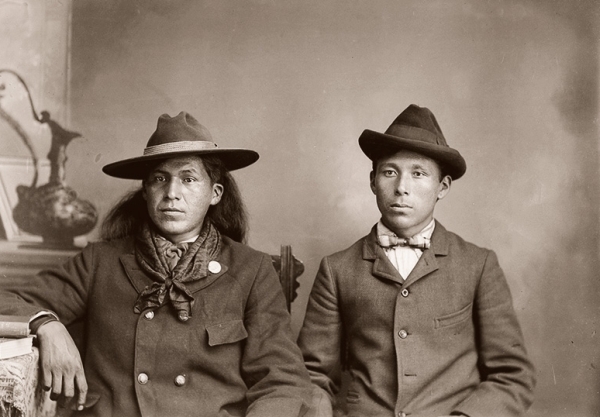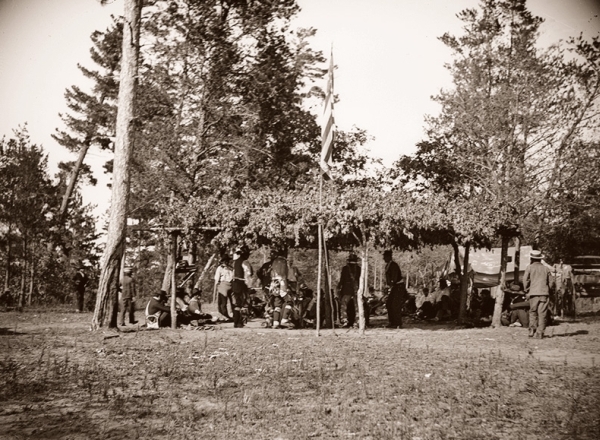IN JULY OF 1908, a weeklong “Homecoming Celebration” took place in Black River Falls to honor the Badger State Banner’s fifty years as the town newspaper. The celebration included an old soldiers program, band concerts, and speeches, as well as parades of bicycles, automobiles, carriages, and Indians on horseback. Besides taking part in the parades, the Ho-Chunk set up a small Indian village just below the Lutheran Church.
Chief George Winneshiek set up two different types of housing for the display: a wigwam (ciiporoke) covered in reed matting and a small teepee of the style used by the Ho-Chunk on short trips for berry picking and hunting. Tribal members also dressed in regalia to sing and dance for the townspeople. The 1908 Homecoming Celebration was not simply a nostalgic look back at the history of Black River Falls. It took its cue from the Ho-Chunk, whose own Homecoming Celebration, based on the tradition of the Haylushka and the powwow, had taken place a few years earlier on tribal land east of the town.
The powwow came to the Winnebago (Ho-Chunk) living in Nebraska from the Omaha Nation after the Civil War in the form of the Haylushka, a warrior honor society that originated with the Pawnee and promoted warrior traditions and values, in particular the selflessness of the true warrior. In 1866 the Omaha presented the Nebraska Winnebago with the ceremony, as well as a drum, roaches, and crow belts. The Nebraska Winnebago used the occasion to honor their veterans, especially those who fought in the Civil War. This ceremony evolved into the Nebraska Winnebago’s Annual Homecoming Celebration Powwow, which has been held every year since 1866. It is recognized as the longest-running powwow in North America.
Like the Nebraska Winnebago, Ho-Chunk living in Wisconsin also used the Haylushka to honor their veterans. The Ho-Chunk hosted their first Haylushka near Black River Falls on July 12, 1888. The Ojibwa traveled from northern Wisconsin to participate and presented three Civil War veterans—John Bigsoldier, John Hazen Hill, and Jim Decorra—with eagle feathers. Mrs. Winneshiek, “Grey Eyes Lady,” was also given a broken feather. The visiting Ojibwa followed the new “Drum Religion” or “Big Drum Religion,” and they presented the Ho-Chunk with a series of ornately decorated Big Drums and introduced them to the teachings of the religion. In return for these gifts, the Ho-Chunk gave the Ojibwa feasts, horses, and other gifts. Ultimately, the Ho-Chunk chose not to follow this new religion, a choice evidenced by their use of a decorated Big Drum during a powwow at the 1908 Homecoming Celebration (see page 106).
The Wisconsin Haylushka later merged with the powwow and became a “Homecoming Celebration.” The powwow, which was a social gathering for dancing Native dances, was never ceremonial, although ceremonial activities might take place. Similar to the Haylushka, the powwow included giveaways to veterans and others to honor them for their sacrifices and good deeds. Gifts and prizes were also presented to the winners of the different games, races, and athletic competitions.
The first Ho-Chunk powwow was held at Frog Place on the first full moon in August 1902. At that powwow, the Omaha came to Wisconsin with four wagonloads of gifts to make amends for offending the Ho-Chunk; years earlier, they had refused to offer assistance during one of the government removals. After 1902, the powwow moved to Big Soldier Place near what was known as Dry Lake Place. In the days of horse and wagon, people traveled great distances to attend and would set up camp for the celebration, which might last between one and two weeks. The guests brought tents that they set up in a circle, with the Sky and Earth clans opposite each other in the traditional way.
The Ho-Chunk Black River Falls powwow is now held twice a year for four days on Memorial Day and Labor Day weekends. The Memorial Day weekend powwow honors all veterans, Ho-Chunk and non-Ho-Chunk, and the Labor Day powwow is usually a contest powwow. Until after World War II, a formal Haylushka dance continued as a separate dance from the powwow. In the 1990s Chief Michael Winneshiek and Kenneth Funmaker Sr. began to revive the Ho-Chunk Haylushka dance. Chief Winneshiek passed away before the first dance was held; his friends and relatives continued the work, and Kenneth Funmaker Sr. hosted the first dance. Just as in early Haylushkas, participants included the Ojibwa and many others from across Indian country.
A group of Ho-Chunk dressed in regalia gather behind an elderly woman and child. The person with the rifle wears an appliqué blanket, as does the woman in the middle of the back row, fourth from left.
Ho-Chunk performers gather behind a drum and Winnebago baskets at the 1908 Homecoming in Black River Falls, Wisconsin. Standing from the left are Jim Swallow (MaPaZoeRayKeKah), William Massey (ChawRoCooChayKah), George Eagle (WaNaKeeScotchKah), Benjamin Thundercloud (NySaGaShiskKah), and Flora Thundercloud Funmaker Bearheart (WaNekChaWinKah). The woman standing on the far right is Susie Lena Pettibone Johnson (ChoNukKaWinKah), and the woman seated to the left is Addie Littlesoldier Lewis Thunder (WauShinGaSaGah). Thomas Thunder (HoonkHaGaKah) is seated beside her behind the drum. Remaining names are unknown.

A Ho-Chunk man dressed in a mix of Native and contemporary clothing dances around singers seated around a drum, ca. 1908.
A cattail mat–covered wigwam (ciiporoke) and a small teepee were set up in a mock Ho-Chunk village for the 1908 Homecoming Celebration.

A group of Ho-Chunk women wrapped in shawls gather at the temporary Ho-Chunk village.
Groups of Ho-Chunk and non-Indians gather on the streets of Black River Falls during the 1908 Homecoming Celebration.

Tourists look on as a group of Ho-Chunk dressed in traditional regalia walks down the street during the Homecoming Celebration.
An unidentified man dances for a group of onlookers in Black River Falls during the 1908 Homecoming Celebration. He wears a Sioux-style eagle feather headdress and carries a Plains-style pipe bag.

A group of performers takes a break from entertaining tourists. The man on the left is wearing a traditional Ho-Chunk beaded shirt, belt, and breechcloth (apron), as well as a Chinese coolie hat. Coolie hats were used by area farmers and available at the general store downtown. The man in the middle is wearing a porcupine roach headdress with an eagle feather, a Ho-Chunk bandolier bag and beaded apron, and Plains-style moccasins.
George Frank Buffalohead (WaChoZhoNoZheeKah), seated, and Sam Carley Blowsnake (HoChunkHaTeKah). Sam was the subject of Paul Radin’s 1920 book, Autobiography of a Winnebago Indian.
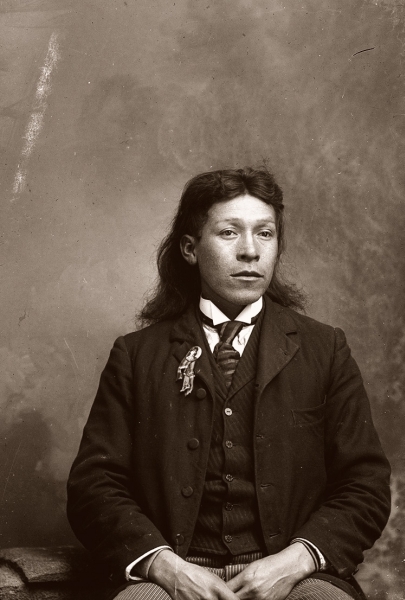
Henry Greencrow (CooNooZeeKah), ca. 1900. Henry has a button on his lapel made from a photograph. Some of Van Schaick’s photographs were made into buttons like this one.
Sam Carley Blowsnake (HoChunkHaTeKah), wearing a hat and sporting long hair, is seated next to Martin Green (Snake) (KeeMeeNunkKah), ca. 1905. Long hair was not a common hairstyle for Ho-Chunk men during this time period but was adopted by some who performed in Wild West shows.
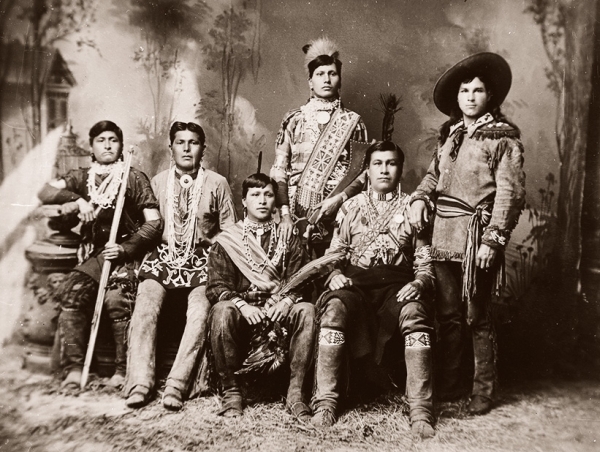
In this photograph, copied by Van Schaick from another photographer, Wild West show promoter Tom Roddy stands on the far right with his cast of performers. From left to right are Thomas Hunker (WaConChaKeeKah), John Whitedog (ChaShepSkaKah), George Littlegeorge (KayRayChaSekSkaKah), Jake Decorra Whiterabbit (MuaHeRooZhooKah), and George Blackhawk (WonkShiekChoNeeKah), ca. 1885.
Ho-Chunk powwow participants. From left to right are an unidentified boy, John Hazen Hill (XeTeNiShaRaKah), William Hall (HunkKah), William Hindsley (Hensley) (CooNooChoNeeNikKah), John (Hoke) Highsnake (HaukSheNeeKah), Thomas Thunder (HoonkHaGaKah), Chief George Winneshiek (WaConChawNeeKah), George Greengrass (WauKeCooPeRayHeKah), John Davis (KaRoJoSepSkaKah), Luke (Duke) Snowball (NySaGaShiskKah), George Lonetree (HoonchXeDaKah), Henry Greencrow (CooNooZeeKah),William Hanson (HoonchHoNoNikKah), and David Goodvillage (WauHeTonChoEKah). Seated behind the drum is George Monegar (EwaOnaGinKah), with Frank Winneshiek (WaConChaHoNoKah) to his left.

A group of Ho-Chunk men are enjoying a game of cards at a powwow.
This arbor was erected for a celebration with the Ojibwe, who traveled from their reservation in northern Wisconsin to participate in the Winnebago-Chippewa Conference of 1895 and to present the Ho-Chunk with a ceremonial drum. Arbors were often used for powwows. Singers would sit around a drum in the center of the arbor, and the dancers would dance in a circle around the drum and singers. At a large powwow, only the drums and singers could fit under the arbor and the dancers would dance around the arbor. An American flag is visible at the front of the arbor.
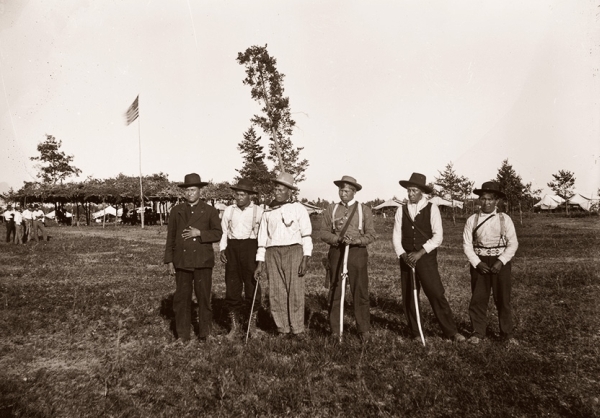
Six Ho-Chunk men line up for a photograph at the powwow grounds, ca. 1910. The men with sticks in their hands are members of the Bear clan, who act as police for the tribe and handle security at tribal events. From left to right are Andrew Bigsoldier (WaConChaShootchKah), Henry Winneshiek (WaConChaRooNayKah), George Monegar (EwaOnaGinKah), Albert Thunder (CheNunkEToKaRaKah), Frank Washington Lincoln (ChakShepKonNeKah), and Max Bearheart (MoNeKah).






